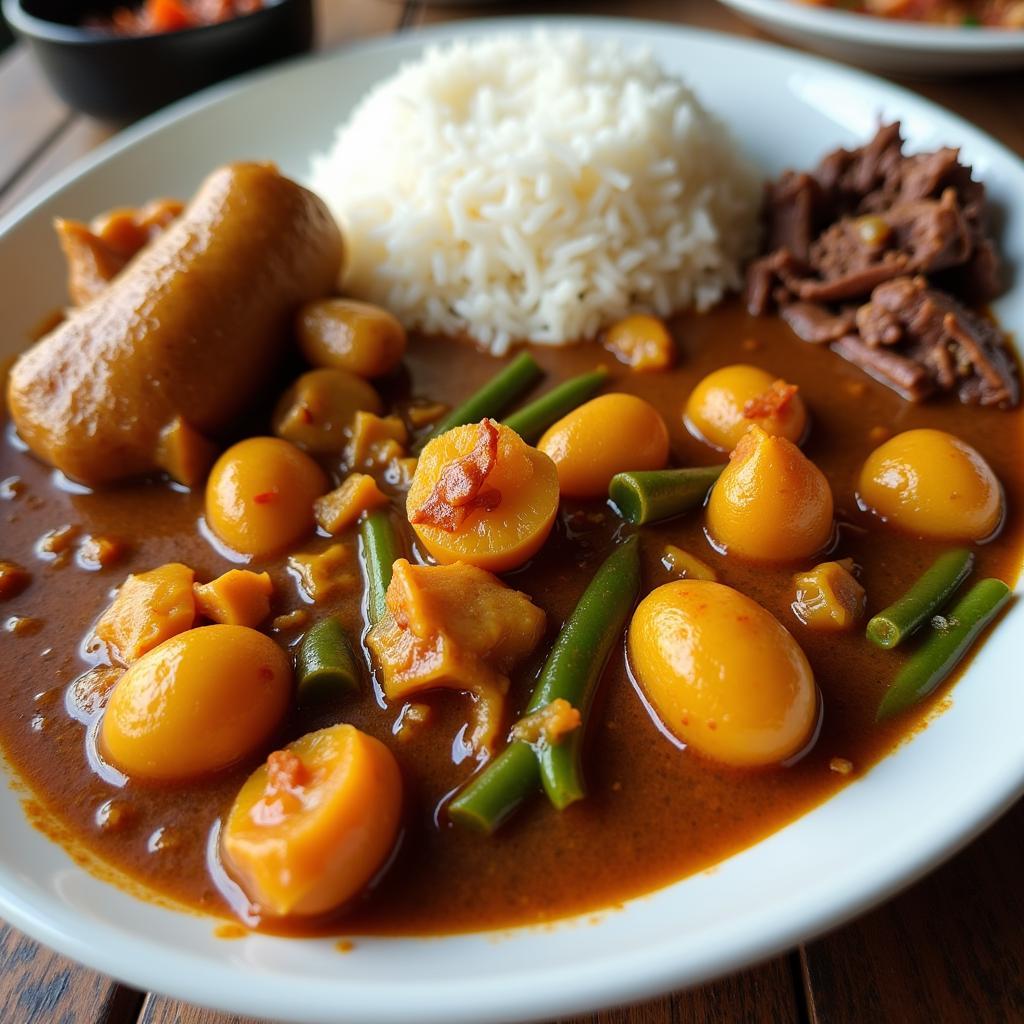Indonesia Food And Culture are deeply intertwined, offering a vibrant tapestry of flavors and traditions. From bustling street food stalls to elaborate ceremonial feasts, Indonesian cuisine reflects the country’s rich history and diverse influences. This article delves into the fascinating world of Indonesian food and culture, exploring its regional variations, key ingredients, and the customs surrounding mealtimes.
A Culinary Journey Through Indonesia’s Diverse Regions
Indonesia, an archipelago of over 17,000 islands, boasts a remarkable diversity of culinary traditions. Each region has its own unique specialties, shaped by local ingredients, cultural influences, and historical events. From the fiery curries of Sumatra to the fragrant spices of the Moluccas, exploring Indonesia’s regional cuisines is like embarking on a flavorful adventure. For example, Padang cuisine, originating from West Sumatra, is renowned for its rich, coconut milk-based curries and generous use of chili peppers. In contrast, Javanese cuisine tends to be sweeter and milder, featuring dishes like gudeg, a jackfruit stew cooked in coconut milk and palm sugar.
 A plate of Javanese Gudeg
A plate of Javanese Gudeg
The Spice Islands and Their Aromatic Legacy
The Moluccas, historically known as the “Spice Islands,” have played a pivotal role in shaping Indonesia’s culinary identity. These islands were once the world’s sole source of nutmeg, cloves, and mace, attracting traders from across the globe. The influence of these aromatic spices is evident in many Indonesian dishes, adding depth and complexity to the flavors. Think of dishes like rendang, a slow-cooked beef stew, which uses a complex blend of spices including ginger, galangal, turmeric, lemongrass, and chilies. You can learn more about the fascinating world of spices in our best thai food cookbook.
Key Ingredients in Indonesian Cuisine
Several key ingredients form the foundation of Indonesian cooking. Rice, a staple food, is consumed with almost every meal. Coconut milk, palm sugar, and a wide variety of spices, including turmeric, ginger, galangal, and chilies, are used to create rich and flavorful sauces. Another common ingredient is tempeh, a fermented soybean product that is both nutritious and versatile. Have you ever tried duck feet as a food? Check out our article on duck feet food.
What are some popular Indonesian dishes?
Some of the most popular Indonesian dishes include nasi goreng (fried rice), satay (grilled skewers of meat), gado-gado (vegetable salad with peanut sauce), and rendang (slow-cooked beef stew). These dishes showcase the diversity and richness of Indonesian cuisine. Are you interested in trying Soto? We offer valuable insights on soto food service.
Cultural Significance of Food in Indonesia
Food plays a central role in Indonesian culture and social life. Meals are often communal affairs, with family and friends gathering to share food and conversation. Many traditional ceremonies and festivals revolve around food, with elaborate feasts prepared to mark special occasions. Even everyday meals are imbued with cultural significance, reflecting the values of hospitality and togetherness. Have you tried Milo? Find more information on this popular drink in our article on milo chocolate malt food drink. It’s a delightful treat enjoyed by many in Indonesia. Interested in trying something different? Take a look at our article about chicken ears food.
Conclusion
Indonesia food and culture offer a captivating journey for the senses. From the vibrant street food scene to the intricate flavors of traditional dishes, exploring Indonesian cuisine is an unforgettable experience. By understanding the regional variations, key ingredients, and cultural significance of food in Indonesia, you can gain a deeper appreciation for this rich and diverse culinary heritage.
FAQ
- What is the national dish of Indonesia? While there isn’t one official national dish, rendang is often considered a national dish due to its popularity and widespread recognition.
- Is Indonesian food spicy? The level of spiciness varies depending on the region and dish. Some dishes are very spicy, while others are milder.
- What are some common Indonesian snacks? Popular snacks include pisang goreng (fried bananas), martabak (stuffed pancake), and various types of kue (traditional cakes).
- What is the etiquette for eating in Indonesia? It is customary to eat with your right hand and to share dishes with others.
- Where can I find Indonesian food? Indonesian restaurants are becoming increasingly popular worldwide. You can also find recipes online and try cooking Indonesian dishes at home.
When you need assistance, please contact Phone Number: 02437655121, Email: minacones@gmail.com Or visit us at: 3PGH+8R9, ĐT70A, thôn Trung, Bắc Từ Liêm, Hà Nội, Việt Nam. We have a 24/7 customer service team.